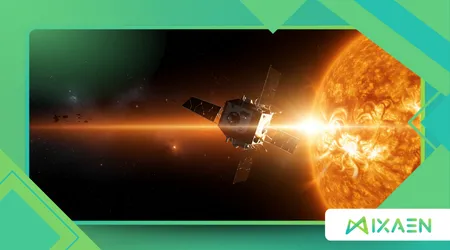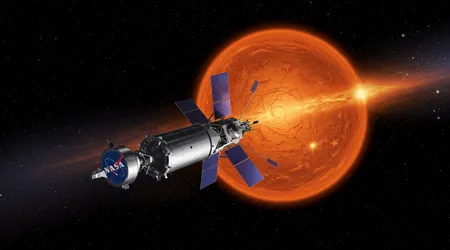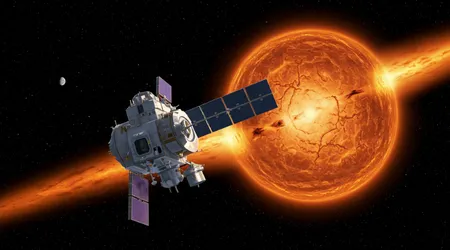How NASA Is Studying the Sun Without Getting Burned

NASA Is Studying the Sun Without Getting Burned in a quest to unravel the star’s mysteries, diving into its fiery heart with unmatched precision.
Anúncios
The Sun, our solar system’s powerhouse, drives life on Earth but also unleashes chaotic forces that can disrupt technology and endanger astronauts.
Through cutting-edge missions like the Parker Solar Probe, NASA is venturing closer to this celestial furnace than ever before, capturing breathtaking data while dodging temperatures that could melt any ordinary spacecraft.
This blog post explores how NASA’s ingenuity, advanced engineering, and relentless curiosity are decoding the Sun’s secrets, safeguarding our planet, and reshaping our understanding of space weather.
Why does the Sun’s fiery temper matter to us? Let’s dive into the science and innovation behind NASA’s solar odyssey.
The Sun’s dynamic nature fascinates scientists, but its volatile behavior demands careful study. Solar flares and coronal mass ejections (CMEs) can wreak havoc on Earth’s infrastructure.
NASA’s heliophysics missions aim to predict these events, protecting satellites and power grids. The stakes are high solar storms have caused billions in damages, like the $500 million loss to farmers in May 2024.
By studying the Sun up close, NASA seeks to forecast space weather with precision. This mission isn’t just about science; it’s about shielding our tech-driven world.
Curiosity about the Sun isn’t new, but NASA’s approach is revolutionary. Past missions observed from afar, limited by distance and technology. Today, NASA’s bold strategy involves diving into the Sun’s outer atmosphere, the corona.
This region, hotter than the Sun’s surface, holds clues to solar wind origins and storm triggers. The challenge?
Surviving temperatures exceeding 1,700°F. NASA’s engineering marvels make this possible, turning science fiction into reality. Let’s explore how they do it.
The Parker Solar Probe: A Fireproof Trailblazer
Imagine a spacecraft zooming through a furnace at 191 km/s, yet emerging unscathed. That’s the Parker Solar Probe, NASA’s crown jewel in solar exploration.
Launched in 2018, it’s the fastest human-made object, designed to “touch” the Sun. On December 24, 2024, it flew just 3.8 million miles from the Sun’s surface, capturing images of solar wind and CMEs in unprecedented detail. This daring mission is rewriting solar science.
The probe’s secret weapon is its Thermal Protection System (TPS), a carbon-composite shield reflecting intense sunlight. While the shield faces 1,700°F, instruments stay at room temperature.
This engineering feat allows the probe to study the corona’s mysteries, like why it’s hotter than the Sun’s surface. Think of the TPS as a cosmic sunscreen, deflecting heat while the probe gathers vital data.
On its 24th orbit in June 2025, the probe observed switchbacks in the solar wind, revealing how magnetic fields twist and snap. These findings help scientists understand space weather origins.
Each pass through the corona provides new insights, with the next scheduled for September 15, 2025. The probe’s resilience is a testament to NASA’s innovative spirit.
++ Could a Solar Superstorm Take Down the Internet?
The data collected isn’t just academic it’s practical. By mapping solar wind behavior, NASA improves space weather forecasts, protecting astronauts and satellites.
For example, a CME in April 2023 caused auroras as far south as Texas, highlighting the need for better predictions. The Parker Probe’s close-up views are a game-changer for preparedness.
Consider a chef crafting a dish in a blazing oven without burning their hands. The Parker Probe does this on a cosmic scale, dipping into the Sun’s atmosphere to sample its fiery ingredients.
This analogy captures the probe’s ability to withstand extreme conditions while delivering scientific breakthroughs. NASA’s mission is a masterclass in balancing risk and reward.

Decoding Solar Phenomena: What NASA’s Learning
The Sun’s behavior is a puzzle, with pieces like solar flares, CMEs, and coronal holes. NASA Is Studying the Sun Without Getting Burned to solve it.
Solar flares, bursts of energy, can disrupt radio communications. CMEs, massive plasma clouds, threaten power grids. NASA’s fleet of spacecraft, from SDO to STEREO, tracks these events in real time.
Coronal holes, dark regions in the corona, release fast solar wind, triggering geomagnetic storms. On July 22, 2025, a coronal hole sparked auroras in Scandinavia.
NASA’s Solar Dynamics Observatory (SDO) captures these events in extreme ultraviolet light, revealing the Sun’s magnetic dance. This data helps predict when storms might hit Earth.
Also read: What We Still Don’t Understand About Solar Flare
The Parker Probe’s close-up images show the heliospheric current sheet, where the Sun’s magnetic field flips. This boundary influences space weather, and understanding it is key to forecasting.
For instance, the probe’s December 2024 images showed multiple CMEs colliding, a rare sight that explains storm intensity. These findings are reshaping heliophysics.
NASA’s missions also study the thermosphere, Earth’s upper atmosphere, affected by solar activity. The GOLD mission found a 90-198°F cooling after a 2023 storm, a surprising discovery.
This data informs satellite orbit predictions, reducing collision risks. NASA’s work connects the Sun’s chaos to Earth’s safety.
Picture a detective piecing together clues from a crime scene. NASA’s spacecraft are cosmic sleuths, gathering evidence from the Sun’s fiery outbursts.
This meticulous approach ensures we’re not caught off guard by solar storms, safeguarding our technology-dependent society.
Engineering Marvels: Surviving the Sun’s Wrath
How does a spacecraft survive a star’s inferno? NASA Is Studying the Sun Without Getting Burned with engineering that defies the odds.
The Parker Probe’s TPS, a 4.5-inch-thick carbon foam shield, reflects 99.9% of solar radiation. It’s like a knight’s armor, protecting delicate instruments from melting.
The probe’s instruments, like WISPR, capture images of solar wind and CMEs. These tools operate in extreme conditions, thanks to cooling systems and robust materials.
For example, WISPR’s December 2024 images showed plasma bursts in stunning detail, revealing CME dynamics. This technology is a triumph of human ingenuity.
NASA’s SDO, orbiting Earth, complements the Parker Probe. Its cameras capture solar flares in multiple wavelengths, like Mario Rana’s July 20, 2025, images in hydrogen-alpha.
These observations help scientists model solar activity, improving storm predictions. The synergy of NASA’s fleet is unmatched.
Read more: How Solar Energy Powers the Heliosphere: Unraveling the Sun’s Cosmic Influenc
Beyond hardware, NASA’s software analyzes vast datasets. HelioCloud, a cloud-based tool, lets scientists process solar data in real time.
This platform ensures rapid insights, critical for timely warnings. It’s like having a supercomputer dedicated to decoding the Sun’s secrets.
The engineering isn’t just about survival it’s about precision. The Parker Probe’s trajectory, calculated to skim the corona, requires pinpoint accuracy.
One misstep could spell disaster. NASA’s ability to navigate these challenges showcases its leadership in space exploration.
Why It Matters: Space Weather and Our World
Solar storms aren’t just cosmic fireworks they impact life on Earth. NASA Is Studying the Sun Without Getting Burned to protect our technology-driven society.
A single CME can disrupt satellites, GPS, and power grids. The 2023 storm’s $500 million damage to farmers underscores the stakes.
Auroras, while beautiful, signal geomagnetic disturbances. The July 2025 coronal hole event brought auroras to northern North America.
NASA’s data helps predict these events, allowing utilities to brace for outages. This foresight saves billions in potential damages.
Astronauts face radiation risks from solar storms. NASA’s missions, like MMS and THEMIS, study how solar particles interact with Earth’s magnetosphere. These insights ensure safer space missions, critical as we plan lunar and Martian expeditions.
Satellites, vital for communication and navigation, are vulnerable to solar activity. NASA’s GOLD mission tracks thermospheric changes, aiding orbit predictions. This protects billion-dollar assets from collisions, ensuring our connected world runs smoothly.
Imagine a city preparing for a hurricane. NASA’s solar research is like a weather forecast for space, giving us time to batten down the hatches. This proactive approach mitigates risks, ensuring our infrastructure withstands the Sun’s fury.
The Future of Solar Exploration

As Solar Cycle 25 peaks in July 2025, NASA’s work is more critical than ever. NASA Is Studying the Sun Without Getting Burned to prepare for heightened activity.
The Parker Probe’s next pass on September 15, 2025, will gather more data, refining our understanding of solar wind origins.
NASA’s TRACERS mission, launched July 23, 2025, studies magnetic reconnection, a driver of solar storms. This mission complements the Parker Probe, offering a multi-angle view of the Sun’s behavior. Future discoveries will enhance storm predictions.
The agency’s budget, though strained, supports the Parker Probe through 2030. This funding ensures continued exploration, even as solar activity declines. NASA’s commitment to heliophysics is a long-term investment in Earth’s safety.
Collaboration is key. NASA partners with NOAA and international agencies to share data. The Solar Cycle 25 Prediction Panel forecasts peak activity, guiding mission planning. This global effort strengthens our resilience against solar threats.
What’s next? NASA’s innovations could inspire missions to study other stars, unlocking cosmic secrets. The Parker Probe’s legacy is just beginning, paving the way for a new era of stellar exploration. The Sun’s mysteries are vast, but NASA’s resolve is unwavering.
Table: Key NASA Missions Studying the Sun (2025)
| Mission | Launch Date | Key Objective | Distance from Sun | Notable Achievement |
|---|---|---|---|---|
| Parker Solar Probe | 2018 | Study solar wind, CMEs | 3.8M miles | Closest-ever images of Sun (Dec 2024) |
| Solar Dynamics Observatory | 2010 | Monitor solar flares, sunspots | Earth orbit | Real-time solar activity imaging |
| STEREO | 2006 | Track CMEs in 3D | Varies | Predicted 2023 storm strength |
| TRACERS | 2025 | Study magnetic reconnection | Earth orbit | Launched July 23, 2025 |
Conclusion: A Brighter Future Through Solar Science
NASA Is Studying the Sun Without Getting Burned, and the implications are profound. From the Parker Probe’s daring dives to SDO’s watchful eye, NASA’s missions illuminate the Sun’s complex nature.
These efforts protect our technology, astronauts, and way of life. The Sun’s power is both a gift and a challenge, driving Earth’s climate while threatening our infrastructure. NASA’s work ensures we harness its energy while mitigating its risks.
The journey isn’t over. As Solar Cycle 25 peaks, NASA’s data will refine space weather forecasts, saving billions in damages.
The Parker Probe’s images, like those from December 2024, are a window into the Sun’s soul, revealing its chaotic beauty. This knowledge empowers us to thrive in a universe shaped by our star.
NASA’s heliophysics missions are a beacon of human curiosity and resilience. They remind us that even the fiercest challenges can be met with ingenuity.
As we look to the stars, NASA’s solar exploration lights the way, ensuring a safer, more connected future. What will the Sun reveal next? Only NASA’s fearless pursuit will tell.
Frequently Asked Questions
Q: How does the Parker Solar Probe survive the Sun’s heat?
A: Its carbon-composite heat shield reflects 99.9% of solar radiation, keeping instruments at room temperature despite 1,700°F external temperatures.
Q: Why is studying the Sun important for Earth?
A: Solar storms can disrupt power grids, satellites, and communications. NASA’s data helps predict these events, protecting infrastructure and astronauts.
Q: What are coronal mass ejections (CMEs)?
A: CMEs are massive plasma clouds ejected from the Sun, carrying magnetic fields that can trigger geomagnetic storms and auroras on Earth.
Q: How does NASA predict solar storms?
A: Using spacecraft like SDO, STEREO, and Parker Probe, NASA monitors solar activity and models space weather for accurate forecasts.
Q: Can I see NASA’s solar images?
A: Yes, NASA’s Solar Dynamics Observatory and Parker Probe images are publicly available on NASA’s website and social media platforms.
